maven笔记
maven地址配置
web网站搜索
https://maven.aliyun.com/repository/public
https://search.maven.org/artifact/org.bitbucket.javatek/jdbc/0.5/jar
<mirror>
<id>aliyun</id>
<mirrorOf>*</mirrorOf>
<name>aliyun maven</name>
<url>https://maven.aliyun.com/repository/central</url>
</mirror>
</mirrors>
配置xml
<?xml version="1.0" encoding="UTF-8"?>
<!--
Licensed to the Apache Software Foundation (ASF) under one
or more contributor license agreements. See the NOTICE file
distributed with this work for additional information
regarding copyright ownership. The ASF licenses this file
to you under the Apache License, Version 2.0 (the
"License"); you may not use this file except in compliance
with the License. You may obtain a copy of the License at
http://www.apache.org/licenses/LICENSE-2.0
Unless required by applicable law or agreed to in writing,
software distributed under the License is distributed on an
"AS IS" BASIS, WITHOUT WARRANTIES OR CONDITIONS OF ANY
KIND, either express or implied. See the License for the
specific language governing permissions and limitations
under the License.
-->
<!--
| This is the configuration file for Maven. It can be specified at two levels:
|
| 1. User Level. This settings.xml file provides configuration for a single user,
| and is normally provided in ${user.home}/.m2/settings.xml.
|
| NOTE: This location can be overridden with the CLI option:
|
| -s /path/to/user/settings.xml
|
| 2. Global Level. This settings.xml file provides configuration for all Maven
| users on a machine (assuming they're all using the same Maven
| installation). It's normally provided in
| ${maven.conf}/settings.xml.
|
| NOTE: This location can be overridden with the CLI option:
|
| -gs /path/to/global/settings.xml
|
| The sections in this sample file are intended to give you a running start at
| getting the most out of your Maven installation. Where appropriate, the default
| values (values used when the setting is not specified) are provided.
|
|-->
<settings xmlns="http://maven.apache.org/SETTINGS/1.0.0"
xmlns:xsi="http://www.w3.org/2001/XMLSchema-instance"
xsi:schemaLocation="http://maven.apache.org/SETTINGS/1.0.0 http://maven.apache.org/xsd/settings-1.0.0.xsd">
<!-- localRepository
| The path to the local repository maven will use to store artifacts.
|
| Default: ${user.home}/.m2/repository
<localRepository>/path/to/local/repo</localRepository>
-->
<localRepository>D:\maven\maven-repo</localRepository>
<!-- interactiveMode
| This will determine whether maven prompts you when it needs input. If set to false,
| maven will use a sensible default value, perhaps based on some other setting, for
| the parameter in question.
|
| Default: true
<interactiveMode>true</interactiveMode>
-->
<!-- offline
| Determines whether maven should attempt to connect to the network when executing a build.
| This will have an effect on artifact downloads, artifact deployment, and others.
|
| Default: false
<offline>false</offline>
-->
<!-- pluginGroups
| This is a list of additional group identifiers that will be searched when resolving plugins by their prefix, i.e.
| when invoking a command line like "mvn prefix:goal". Maven will automatically add the group identifiers
| "org.apache.maven.plugins" and "org.codehaus.mojo" if these are not already contained in the list.
|-->
<pluginGroups>
<!-- pluginGroup
| Specifies a further group identifier to use for plugin lookup.
<pluginGroup>com.your.plugins</pluginGroup>
-->
</pluginGroups>
<!-- proxies
| This is a list of proxies which can be used on this machine to connect to the network.
| Unless otherwise specified (by system property or command-line switch), the first proxy
| specification in this list marked as active will be used.
|-->
<proxies>
<!-- proxy
| Specification for one proxy, to be used in connecting to the network.
|
<proxy>
<id>optional</id>
<active>true</active>
<protocol>http</protocol>
<username>proxyuser</username>
<password>proxypass</password>
<host>proxy.host.net</host>
<port>80</port>
<nonProxyHosts>local.net|some.host.com</nonProxyHosts>
</proxy>
-->
</proxies>
<!-- servers
| This is a list of authentication profiles, keyed by the server-id used within the system.
| Authentication profiles can be used whenever maven must make a connection to a remote server.
|-->
<servers>
<!-- server
| Specifies the authentication information to use when connecting to a particular server, identified by
| a unique name within the system (referred to by the 'id' attribute below).
|
| NOTE: You should either specify username/password OR privateKey/passphrase, since these pairings are
| used together.
|
<server>
<id>deploymentRepo</id>
<username>repouser</username>
<password>repopwd</password>
</server>
-->
<!-- Another sample, using keys to authenticate.
<server>
<id>siteServer</id>
<privateKey>/path/to/private/key</privateKey>
<passphrase>optional; leave empty if not used.</passphrase>
</server>
-->
</servers>
<!-- mirrors
| This is a list of mirrors to be used in downloading artifacts from remote repositories.
|
| It works like this: a POM may declare a repository to use in resolving certain artifacts.
| However, this repository may have problems with heavy traffic at times, so people have mirrored
| it to several places.
|
| That repository definition will have a unique id, so we can create a mirror reference for that
| repository, to be used as an alternate download site. The mirror site will be the preferred
| server for that repository.
|-->
<mirrors>
<!-- mirror
| Specifies a repository mirror site to use instead of a given repository. The repository that
| this mirror serves has an ID that matches the mirrorOf element of this mirror. IDs are used
| for inheritance and direct lookup purposes, and must be unique across the set of mirrors.
|
<mirror>
<id>mirrorId</id>
<mirrorOf>repositoryId</mirrorOf>
<name>Human Readable Name for this Mirror.</name>
<url>http://my.repository.com/repo/path</url>
</mirror>
-->
<mirror>
<id>aliyun</id>
<mirrorOf>*</mirrorOf>
<name>aliyun maven</name>
<url>https://maven.aliyun.com/repository/central</url>
</mirror>
</mirrors>
<!-- profiles
| This is a list of profiles which can be activated in a variety of ways, and which can modify
| the build process. Profiles provided in the settings.xml are intended to provide local machine-
| specific paths and repository locations which allow the build to work in the local environment.
|
| For example, if you have an integration testing plugin - like cactus - that needs to know where
| your Tomcat instance is installed, you can provide a variable here such that the variable is
| dereferenced during the build process to configure the cactus plugin.
|
| As noted above, profiles can be activated in a variety of ways. One way - the activeProfiles
| section of this document (settings.xml) - will be discussed later. Another way essentially
| relies on the detection of a system property, either matching a particular value for the property,
| or merely testing its existence. Profiles can also be activated by JDK version prefix, where a
| value of '1.4' might activate a profile when the build is executed on a JDK version of '1.4.2_07'.
| Finally, the list of active profiles can be specified directly from the command line.
|
| NOTE: For profiles defined in the settings.xml, you are restricted to specifying only artifact
| repositories, plugin repositories, and free-form properties to be used as configuration
| variables for plugins in the POM.
|
|-->
<profiles>
<profile>
<id>jdk-1.8</id>
<activation>
<activeByDefault>true</activeByDefault>
<jdk>1.8</jdk>
</activation>
<properties>
<maven.compiler.sour>1.8</maven.compiler.sour>
<maven.compiler.target>1.8</maven.compiler.target>
<maven.compiler.compilerVersion>1.8</maven.compiler.compilerVersion>
</properties>
</profile>
<!-- profile
| Specifies a set of introductions to the build process, to be activated using one or more of the
| mechanisms described above. For inheritance purposes, and to activate profiles via <activatedProfiles/>
| or the command line, profiles have to have an ID that is unique.
|
| An encouraged best practice for profile identification is tocompilerVersion use a consistent naming convention
| for profiles, such as 'env-dev', 'env-test', 'env-production', 'user-jdcasey', 'user-brett', etc.
| This will make it more intuitive to understand what the set of introduced profiles is attempting
| to accomplish, particularly when you only have a list of profile id's for debug.
|
| This profile example uses the JDK version to trigger activation, and provides a JDK-specific repo.
<profile>
<id>jdk-1.4</id>
<activation>
<jdk>1.4</jdk>
</activation>
<repositories>
<repository>
<id>jdk14</id>
<name>Repository for JDK 1.4 builds</name>
<url>http://www.myhost.com/maven/jdk14</url>
<layout>default</layout>
<snapshotPolicy>always</snapshotPolicy>
</repository>
</repositories>
</profile>
-->
<!--
| Here is another profile, activated by the system property 'target-env' with a value of 'dev',
| which provides a specific path to the Tomcat instance. To use this, your plugin configuration
| might hypothetically look like:
|
| ...
| <plugin>
| <groupId>org.myco.myplugins</groupId>
| <artifactId>myplugin</artifactId>
|
| <configuration>
| <tomcatLocation>${tomcatPath}</tomcatLocation>
| </configuration>
| </plugin>
| ...
|
| NOTE: If you just wanted to inject this configuration whenever someone set 'target-env' to
| anything, you could just leave off the <value/> inside the activation-property.
|
<profile>
<id>env-dev</id>
<activation>
<property>
<name>target-env</name>
<value>dev</value>
</property>
</activation>
<properties>
<tomcatPath>/path/to/tomcat/instance</tomcatPath>
</properties>
</profile>
-->
</profiles>
<!-- activeProfiles
| List of profiles that are active for all builds.
|
<activeProfiles>
<activeProfile>alwaysActiveProfile</activeProfile>
<activeProfile>anotherAlwaysActiveProfile</activeProfile>
</activeProfiles>
-->
</settings>
中央仓库
是一个网络仓库,存储jar包和maven插件
阿帕奇1
阿帕奇2
带图形界面
上面两个是一样的,相当于ftp,第3个带图形界面。(3个都是外国网址)
本地仓库
从中央仓库下载的jar包的存放位置,也是一个仓库,只不过是存放在本地电脑上
镜像仓库
对某一仓库做的镜像 阿里云提供的nexus私服(不能浏览,但能用)
http://maven.aliyun.com/nexus/content/groups/public/
私服
局域网内部搭建的maven服务器(公司不能连外网,只有部分能连外网)
单词
repository 仓库
archetype 原型、骨架(模板)
artifact 手工制品,成品(项目/jar/war)
配置环境变量
Windows
Maven依赖于JAVA_HOME
echo %JAVA_HOME% echo $JAVA_HOME
Maven环境变量:
M2_HOME=Maven安装目录
PATH=%M2_HOME%/bin
测试:mvn -version(cmd命令)
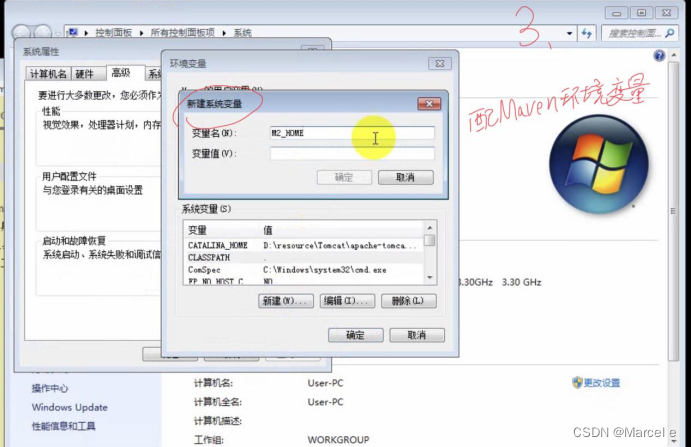
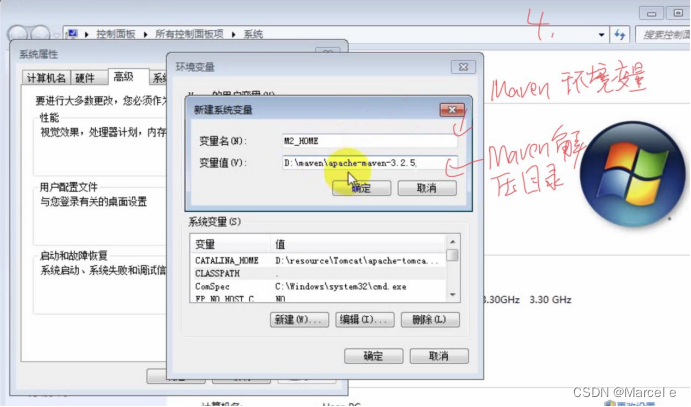
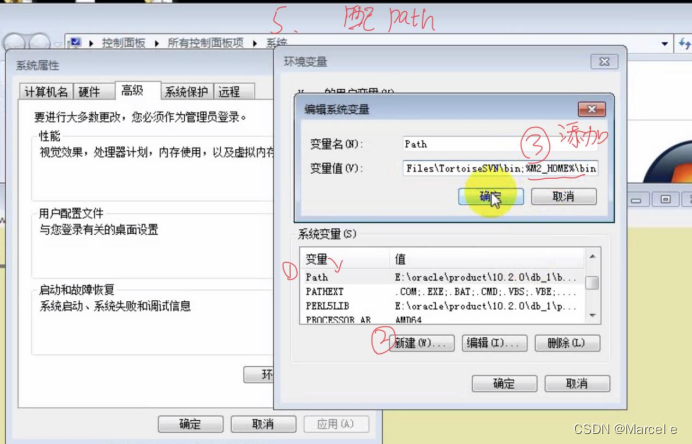
Linux/Mac OS
编辑/home/soft01/.bashrc文件,在最后一行添加内容:
cd /home/soft01
vi .bashrc
export M2_HOME=/home/soft01/maven/apachemaven3.2.5
export PATH=$PATH:$M2_HOME/bin
使修改立即生效:
source .bashrc
测试:mvn -version
成功的界面:
Apache Maven 3.2.5 (12a6b3acb947671f09b81f49094c53f426d8cea1; 201412 15T01:29:23+08:00) Maven home: /home/soft01/maven/apachemaven3.2.5 Java version: 1.7.0_80, vendor: Oracle Corporation Java home: /usr/lib/jvm/java7oracle/jre Default locale: zh_CN, platform encoding: UTF8 OS name: "linux", version: "3.16.030generic", arch: "i386", family: "unix"
配置本地仓库
本地仓库的默认位置
~/.m2/repository
修改本地仓库的位置
编辑conf/setting.xml
<localRepository>D:\maven\mavenrepo</localRepository>
测试:
cd maven/mavenprojects
mvn archetype:generate #创建maven项目
提示:选择创建项目时使用的模板archetype:
按回车 输入groupId,一般为组织域名反向+项目名:com.itany.ums
输入artifactId:test 版本:按回车
包名:按回车 确认:按回车
配置镜像仓库
编辑conf/setting.xml
<mirrors>
<mirror>
<id>aliyun</id>
<mirrorOf>*</mirrorOf> <! 所有访问都使用该镜像仓库 >
<name>aliyun maven</name> <url>http://maven.aliyun.com/nexus/content/groups/public/</url>
</mirror>
</mirrors>
配置Maven的JDK版本
默认使用maven创建的项目使用的是jdk1.5
修改maven默认使用的jdk版本,编辑conf/setting.xml,
在profiles标签中添加如下内容:
<profile>
<id>jdk‐1.7</id>
<activation>
<activeByDefault>true</activeByDefault>
<jdk>1.7</jdk>
</activation>
<properties>
<maven.compiler.source>1.7</maven.compiler.source>
<maven.compiler.target>1.7</maven.compiler.target>
<maven.compiler.compilerVersion>1.7</maven.compiler.compilerVersion>
</properties>
</profile>
创建Maven项目
1. Java项目的创建
2. 目录结构
Java工程约定的目录结构如下:
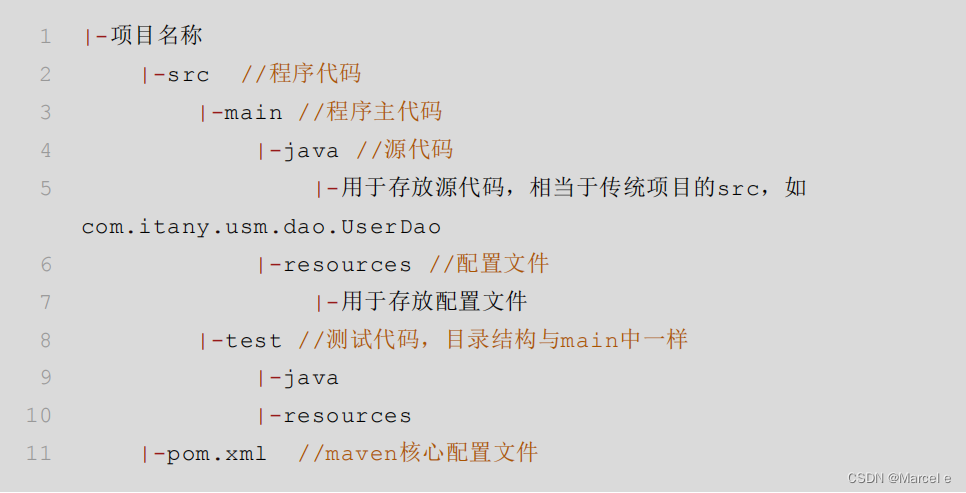
基本操作 步骤:
1. 创建Java项目
mvn archetype:generate
指定的信息如下:
archetype:(mavenarchetypequickstart) #使用骨架创建java项目
groupId:com.itany.study #指定组织域名反向+项目名 artifactId:sms
#指定模块名称
version:1.0.1 #版本
package:com.itany.study #包名
2. 执行maven操作
cd sms #先切换到项目所在的目录
mvn compile
mvn clean compile test #可以同时执行多个命令
自定义Java类
2. Web项目的创建
目录结构
Web项目的约定目录结构如下:
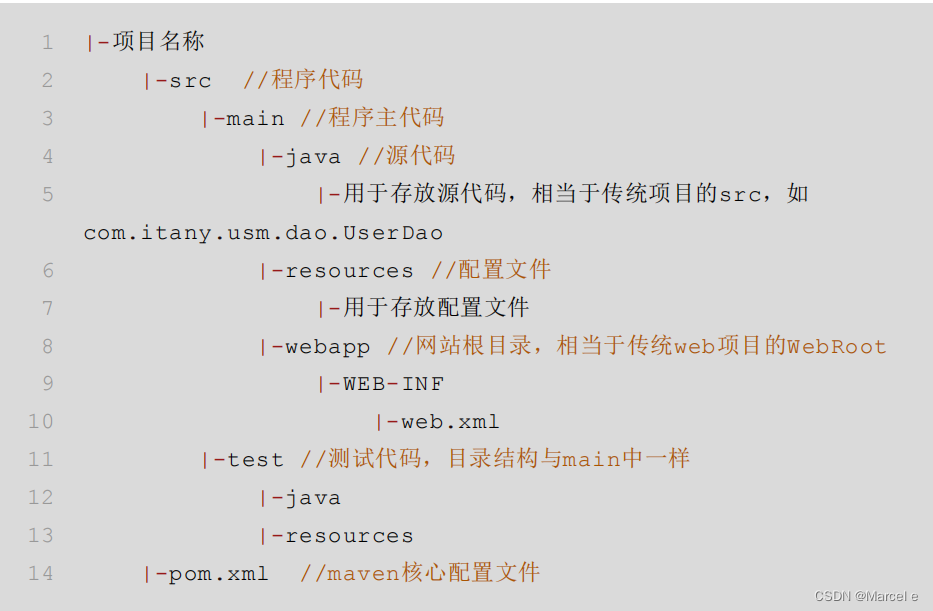
基本操作
步骤:1. 创建web项目
mvn archetype:generate
指定的信息如下:
archetype:(mavenarchetypewebapp) #使用模板创建web项目 .....
执行maven操作
mvn clean compile package
发布方式1:使用外部的tomcat 将shop.war包复制到webapps目录下,然后启动tomcat
cd tomcat.../bin
./startup.sh
方式2:使用maven的tomcat插件
mvn tomcat:run
访问
http://localhost:8080/shop
Maven命令
1. 常用命令
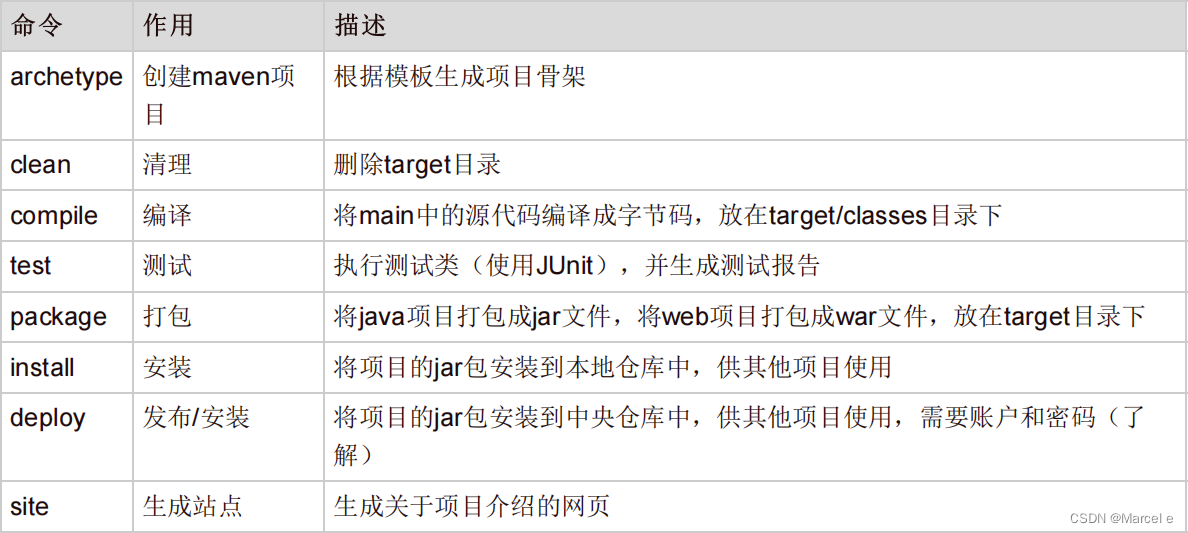
注意: 所有的命令都要跟在mvn的后面,
如mvn archetype 所有的命令都必须在某个项目的根目录
多个命令可以一起执行
生命周期
一个项目的构建build的过程通常包括:清理、编译、测试、打包、集成测试、部署等 Maven定义了三套生命周期:clean、default、site 每个生命周期之间是互相独立,每个生命周期内都包含多个阶段,这些阶段是有顺序的,后续的阶段 必须等待前面的阶段执行后才能执行 default生命周期包含:compile、test、package
pom.xml文件
- 简介pom:project object model 项目对象模型 pom.xml是Maven的核心配置文件 一个Maven项目有且只有一个pom.xml文件,该文件必须在项目的根目录下
坐标详解
Maven坐标是通过一些元素来定义:groupId、artifactId、version
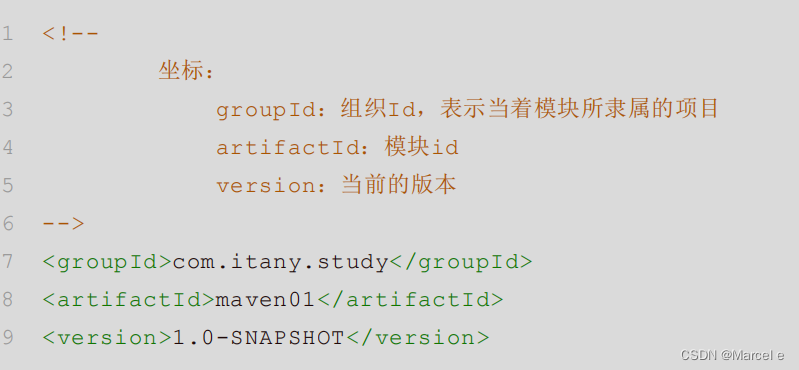
dependency
基本配置
如何查找一个jar包的坐标?(网址)
maven1
或
maven2
或阿里云,失效了
国内阿里云
<dependency>
<groupId>mysql</groupId>
<artifactId>mysqlconnectorjava</artifactId>
<version>5.1.38</version>
</dependency> <dependency>
<groupId>commonsfileupload</groupId>
<artifactId>commonsfileupload</artifactId>
<version>1.3.1</version>
</dependency>
<dependency>
<groupId>log4j</groupId>
<artifactId>log4j</artifactId>
<version>1.2.17</version>
</dependency>
scope作用域
表示依赖的作用域,用来配置依赖的jar包可使用的范围

properties 全局属性
一般情况下用于定义全局的jar包版本
<properties>
<project.build.sourceEncoding>UTF8</project.build.sourceEncoding> <fileupload.version>1.3.1</fileupload.version>
<junit.version>4.12</junit.version>
<mysqlconnectorjava.version>5.1.38</mysqlconnectorjava.version> <spring.version>4.3.12.RELEASE</spring.version>
</properties>
<dependencies> <! junit > <dependency>
<groupId>junit</groupId>
<artifactId>junit</artifactId>
<version>${junit.version}</version>
<scope>test</scope>
</dependency>
</dependencies>
repositories
用来配置当前工程使用的远程仓库
依赖查找顺序:本地仓库——>当前工程pom.xml中配置的远程仓库——>setting.xml中配置的远程仓 库
<! 配置远程仓库 >
<repositories> <! 有些最新的jar包,可能在中央仓库上并没有提供,此时可以使用jar包官方提供的仓库 ><repository>
<id>spring_repo</id>
<url>http://repo.spring.io/milestone</url>
</repository>
</repositories>
plugins 配置插件
是一种工具 mavencleanplugin mavencompileplugin
<! mavencleanplugin>
<plugin>
<groupId>org.apache.maven.plugins</groupId>
<artifactId>mavencleanplugin</artifactId>
<version>2.6.1</version>
</plugin> <! tomcat插件 > <plugin>
<groupId>org.apache.tomcat.maven</groupId>
<artifactId>tomcat7mavenplugin</artifactId>
<version>2.2</version>
<configuration>
<path>/maven01</path>
<port>8888</port>
</configuration>
</plugin>
超级POM
所有的pom.xml文件都继承一个父POM,这个父POM称为超级POM(Super POM、Effective POM)
Maven中的关系
1.继承
一个Maven项目可以继承自另一个Maven项目,分为称为子项目、父项目 场景:多个子项目中使用的是相同的依赖或插件,此时可以把相同的配置抽取到一个父项目中,进行 统一的管理,保持一致性 步骤:1. 将父项目的打包方式设置为pom

2. 在子项目中引用父项目,指定父项目的坐标
<! 引用父项目,指定父项目的坐标 >
<parent>
<groupId>com.itany.study</groupId>
<artifactId>parent</artifactId>
<version>1.0SNAPSHOT</version> <! 指定父项目的pom.xml文件的相对物理路径 >
<relativePath>../parent/pom.xml</relativePath>
</parent>
问题:有时并不是父项目的所有依赖都需要被子项目继承,但是又希望能够通过父项目对依赖进行统 一管理,如版本的控制 解决:使用dependencyManagement 步骤:1. 在父项目中配置dependencyManagement 2. 在子项目中引用父项目中的依赖
Maven Web项目
步骤:1. 修改web.xml文件
<?xml version="1.0" encoding="UTF8"?>
<webapp xmlns="http://xmlns.jcp.org/xml/ns/javaee"
xmlns:xsi="http://www.w3.org/2001/XMLSchemainstance"
xsi:schemaLocation="http://xmlns.jcp.org/xml/ns/javaee
http://xmlns.jcp.org/xml/ns/javaee/webapp_3_1.xsd" version="3.1">
</webapp>
- 配置pom.xml
<dependencies> <! Java EE > <dependency> <groupId>javax.servlet</groupId> <artifactId>javax.servletapi</artifactId> <version>3.1.0</version> <scope>provided</scope> </dependency> <dependency> <groupId>javax.servlet.jsp</groupId> <artifactId>jspapi</artifactId> <version>2.2</version> <scope>provided</scope> </dependency> <dependency> <groupId>jstl</groupId> <artifactId>jstl</artifactId> <version>1.2</version> </dependency> </dependencies> <build> <finalName>maven02</finalName> <! tomcat插件 > <plugins> <plugin> <groupId>org.apache.tomcat.maven</groupId> <artifactId>tomcat7mavenplugin</artifactId> <version>2.2</version> <configuration> <path>/</path> <port>8888</port> </configuration> </plugin> </plugins> </build>
使用Nexus搭建Maven私服
- 为什么要搭建私服 公司不提供外网给开发人员,无法使用maven访问远程仓库,此时可以在局域网内找一台能访问外网 的电脑搭建maven私服
- Nexus工具 用来搭建nexus工具 3. 操作步骤 步骤:1. 解压缩并安装为系统服务
nexus2.14.201bundle\nexus2.14.201\bin\jsw\windowsx86 64\installnexus.bat
- 访问
- http://localhost:8081/nexus
5 登陆并配置私服 登陆账户和密码:admin/admin123 - 添加阿里云代理(镜像)仓库到私服中
- 添加本地jar到私服中
相关文章
简介
下载后代开nexus的网址(已存百度云)
http://localhost:8081/nexus
百度网盘地址:
http://pan.baidu.com/s/1mgznhd2
下载地址
私服搭建步骤
解压

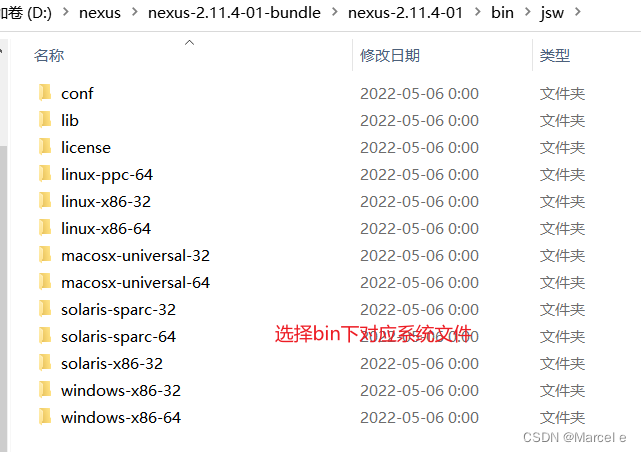
运行
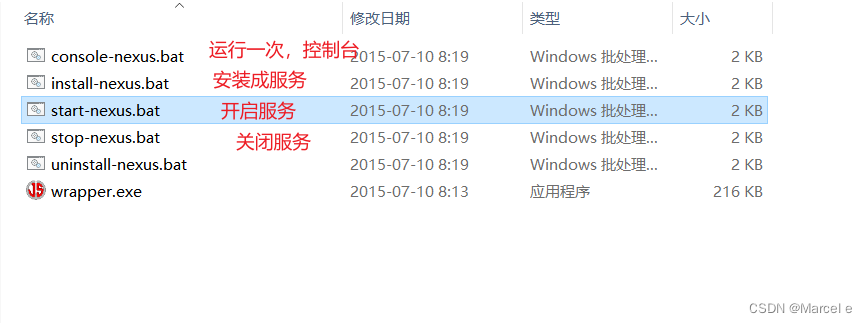
访问localhost:8081/nexus
admin
pw:admin123
搜索

私服网址,把maven修改成私服网址
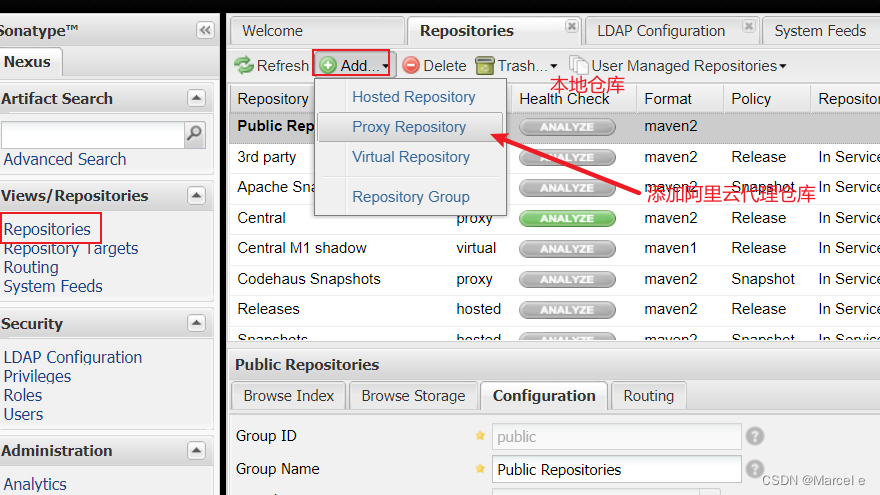
修改地址
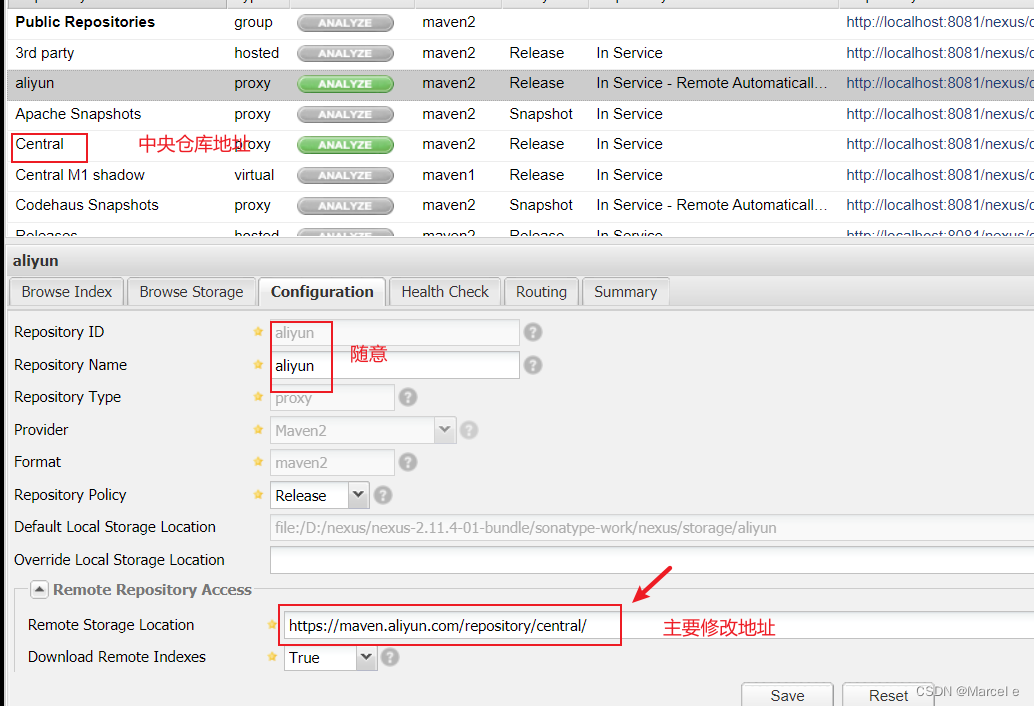
配置仓库查找顺序

中央仓库没有的jar,自定义jar的上传,在pom用自定义的坐标



可一次加多个jar























 341
341











 被折叠的 条评论
为什么被折叠?
被折叠的 条评论
为什么被折叠?








